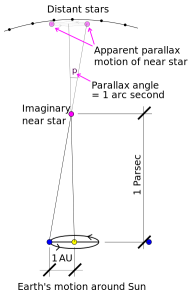
Astronomy Magazine," Why is a parsec 3.26 light-years? (opens in new tab)".NASA, " Imagine the Universe: The Milky Way (opens in new tab)",.Oxford Reference, " Parsec (opens in new tab)".The International Astronomical Union (opens in new tab) similarly contains a wealth of material on the subject. The Royal Astronomical Society (opens in new tab) has information and articles on its site relating to parsecs. Today, the International Astronomical Union (opens in new tab) recommends the use of parsecs over light-years in scientific papers, although the latter is still very common in popular usage. Then around 1913 Herbert Hall Turner had the idea of shortening this to parsec - and the name stuck, even when other, non-parallax-based, methods of measuring stellar distance were developed. The answer seems to be that, when astronomers first started measuring stellar distances using the parallax method, they simply presented their results in terms of "a parallax of X seconds" rather than converting to light-years. Hubble’s law: Why are most galaxies moving away from us? (opens in new tab)

#Parsec distance how to
Henrietta Swan Leavitt: Discovered How to Measure Stellar Distances Gaia spacecraft: Mapping the Milky Way like never before So why would anyone want to use parsecs instead? The light-year even has a usefulness that goes beyond simple measurement, because it tells us that when we observe an object X light-years away, we’re seeing as it was X years in the past. It’s simply the distance that light travels in a year, and it’s been in use since at least 1838. By contrast, the light-year is much easier to understand. Parsec vs light yearĪs logical as the definition of a parsec is, it’s still likely to come across as unnecessarily complicated to most people. In fact, real stellar parallaxes are smaller than that, meaning that their distances are always greater than a parsec. So that’s where the parsec comes from: it’s the hypothetical distance at which a star would show a parallax of exactly one second. Measuring that angle and then halving it (because we have two equal and opposite offsets relative to the Sun) gives us the star’s parallax. The star will appear to have moved through a small angular distance relative to the background objects. Then six months later, when the Earth is on the other side of the sun, they take another photograph of the same bit of sky, according to NASA.
#Parsec distance Patch
They take a photograph of a patch of sky containing the star they’re interested in and other, more distant objects such as galaxies. The same principle enables astronomers to measure the distance to nearby stars.

If you could measure that angular difference, then knowing the distance between your eyes enables you to calculate the distance to the pencil. That’s the parallax effect, and it happens because the angular direction to the pencil is slightly different when seen by your left and right eyes. The distance from the Sun of a body with a parallax angle of 1 arcsecond was thus defined as a unit and, thanks to Turner, named the parsec.Parallax can be demonstrated by looking at a pencil with one eye or the other. Once the parallax angle is established you can calculate the distance to a star using trigonometry, because we know Earth’s distance from the Sun. The parallax angle is obtained by halving the angular difference in measurements. The parallax angle is found by measuring the parallax motion (or apparent movement of a star relative to stable, more distant stars) when the star is observed from opposite sides of the Sun (an interval of six months on Earth). Astronomers used trigonometry to calculate the distance to stars long before the term parsec was coined, but the new unit made it easier to conceptualise unfathomable distances.Ī parsec is the distance from the sun to an astronomical object which has a parallax angle of one arcsecond (1/3600 of a degree).


 0 kommentar(er)
0 kommentar(er)
